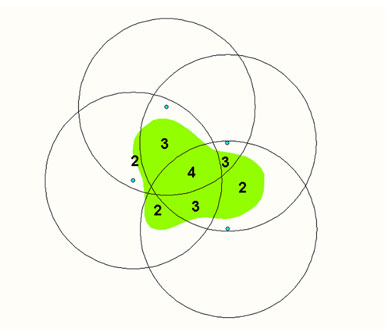Using virtual irrigation to forecast disease
Poster presentation at the 2008 American Phytopathological Society meetings, July 26 - 30, Minneapolis, MN.
Authors: Larry Stowell and Wendy Gelernter (PACE Turfgrass Research Institute) and Frank Wong and Chi-Men Chen, University of California Riverside
Click here to view the poster (130 KB)
Summary: Recent research suggests that soil moisture impacts the severity of turf diseases such as anthracnose caused by Colletotrichum cereale, Pythium root dysfunction caused by Pythium volutum, gray leaf spot (GLS) caused by Magnaporthe grisea and brown ring patch (BRP) caused by Waitea circinata var. circinata. The virtual irrigation audit, a simple computer model that predicts the size and location of both wet and dry areas on golf course turf, was designed to provide diagnosticians and turf managers with a precision turfgrass management tool for disease and soil moisture management. In this study, the virtual audit was successfully used to describe the occurrence of GLS and BRP on golf course turf.
Virtual Irrigation Audit
In PACE's presentation at the 2007 Crop Science Society of America (CSSA) meetings, we introduced a concept that we have dubbed "the virtual irrigation audit" which will make it possible, in the near future, to conduct an audit of your irrigation system that does not involve catch cans or even running the irrigation system. While catch-can audits are still necessary for a comprehensive evaluation of irrigation system performance, the virtual irrigation audit can be a fast and fairly accurate diagnostic tool. The same system can also be used to evaluate and improve irrigation system designs even before they are installed. In these days of water shortages and drought-related problems on turf, this is an approach that we believe can save time, money and turf damage.
Our presentation can be found at this link: "Virtual Irrigation Audit"(1,288 KB). A brief summary of the presentation appears below.
Irrigation design problems frequently result in turfgrass stress and damage. Although catch-can evaluations to determine irrigation distribution uniformity are the standard practice, they are cumbersome to conduct and are not practical for diagnostic purposes in real-time. To improve the efficiency of visualizing and diagnosing irrigation design problems, we performed virtual irrigation audits using the following tools:
- a Trimble AgGPS 132 sub-meter GPS receiver
- HGIS software from StarPal
- a TDS Recon hand held computer
(For more information on these tools, see this PACE article on "Precision Management Tools")
Golf course green, tee and fairway perimeters, irrigation sprinkler locations, and the theoretical throw of each irrigation head are easily mapped. The graphics that are generated from this process (see rough map, turf racetrack map and green map) illustrate clearly how water is being distributed from irrigation heads, locates where potential problem areas (too wet or too dry) are likely to occur, and helps diagnose the causes of water-related problems.
In the course of our study, we confirmed what many of you already know — that irrigation designs are woefully deficient in delivering water uniformly to the entire turf surface. In some cases, we found portions of greens that received only 50% of the water that was applied to the wettest areas of the same greens. Deep and infrequent irrigation will help to compensate for these flaws in design, but require heavy water use and may not be sufficient in and of themselves on poa greens where roots are shallow. If short irrigation sets (10 minutes per cycle) are necessary (for example, on poa greens), hand watering will be required to even out soil moisture in areas that receive too little water during the cycle.
Testing the Aqua-PhyD Water Conditioner
Summary: A study was designed to evaluate the water quality claims made for the Aqua-PhyD water conditioner, specifically the company brochure’s claim that "Reclaimed water is perfect for the AQUA-PHYD system. It will significantly reduce the salts and chlorides found in reclaimed, run-off, and recycled water".
Analytical tests were conducted on water before and after passing through the Aqua-PhyD water conditioner that had been installed between the irrigation lake and irrigation heads on a California golf course. The results indicate that the Aqua-PhyD water conditioner did not alter any parameters of irrigation water chemical composition, including salts and chlorides, as evaluated using standard analytical chemical methods.
Aqua-PhyD’s literature also claims beneficial effects on soils as well. The impact of the Aqua-PhyD water conditioner on soil quality was not evaluated in this study.
The full print version of this report (14Kb) is now available on PACE's Super Journal website.
Principal investigators: Larry Stowell, Ph.D., CPAg (PACE Turfgrass Research Institute)





